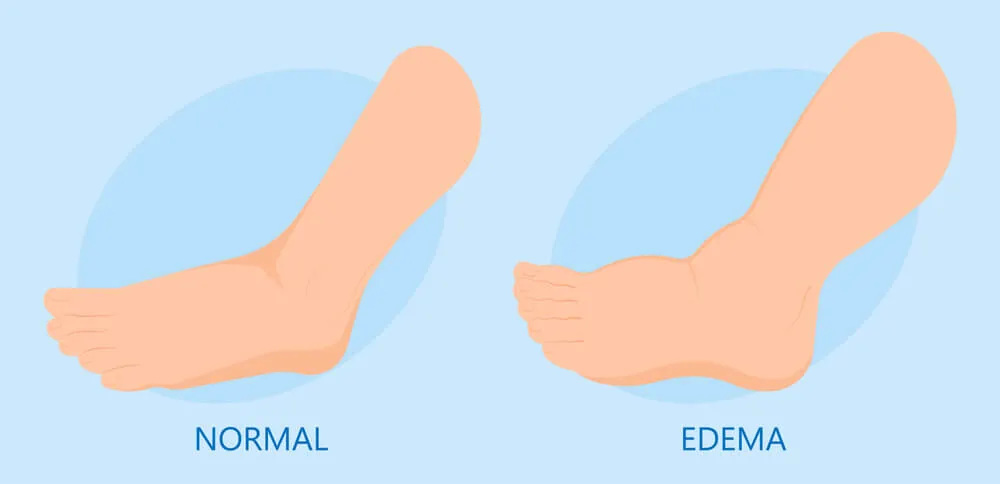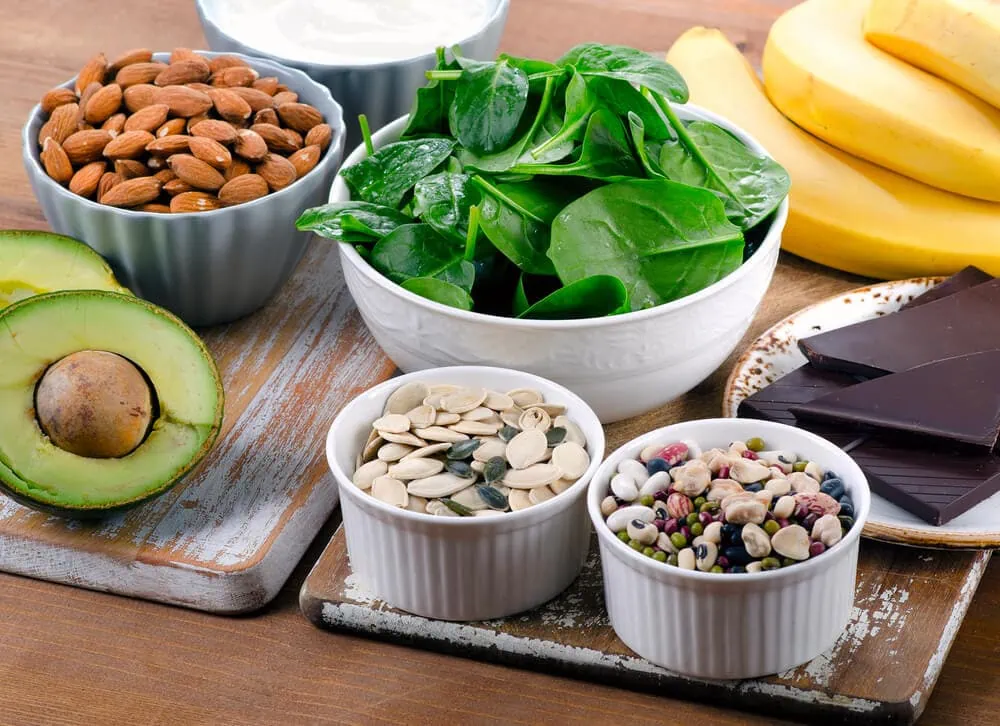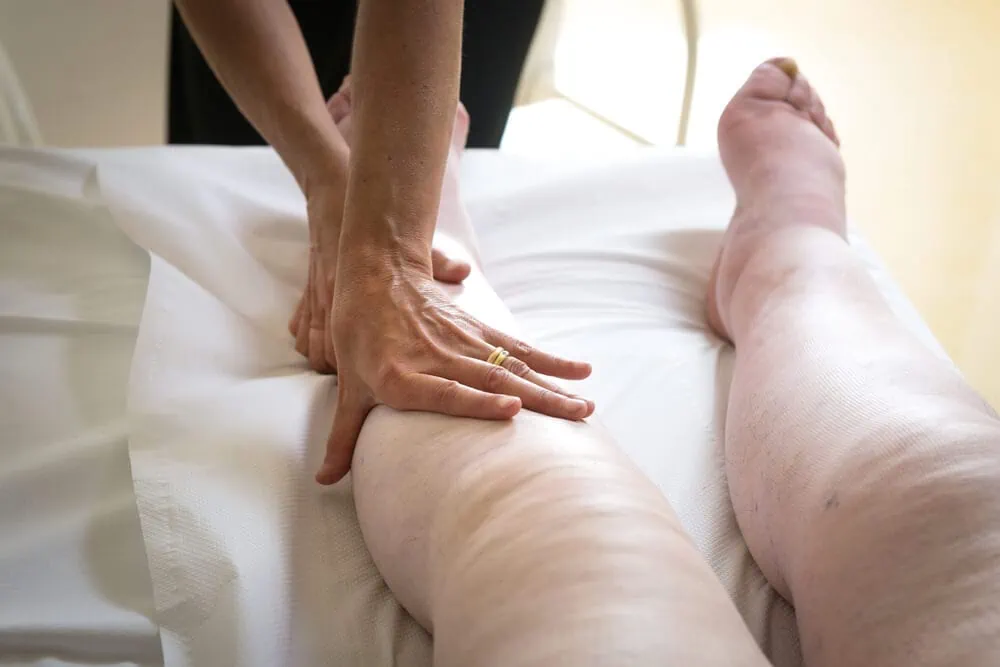Edema affects up to 20% of adults in Canada and the United States. Edema can be due to a number of underlying health conditions, leading to fluid accumulation in tissues. This can often lead to significant discomfort and may even make it more difficult to complete daily tasks.
What is Edema?
Edema is the accumulation of fluid leading to swelling. This occurs when fluid moves from the vasculature to the space between the cells. Due to the effect of gravity, this usually occurs in the lower legs and feet. However, it can also occur in the arms, hands, face and abdomen.

There are some at-home remedies that can help reduce swelling and ease discomfort. These remedies can help to offer short-term relief while addressing the underlying cause of the edema.
What Are the Causes of Edema?
Edema is most commonly associated with heart failure or poor cardiovascular health, but there are a number of conditions that can cause edema. The build-up of fluid causes edema in the space between the cells, known as the interstitial space. When there is inflammation or increased blood pressure, fluid is pushed from the vasculature into the interstitial space.
There are many conditions that can cause edema, including, but not limited to:
- Heart disease: The heart can not effectively pump blood. This leads to a backup in the veins of the body. This excess fluid leads to edema.
- Pregnancy: In pregnancy, the increased fluid and pressure from the uterus can cause a backup in the pelvic veins. This can lead to edema, especially in the lower limbs.
- Allergy, Fracture or Infection: All of these cause Edema due to a defence mechanism. The increased vascular permeability allows for white blood cells (WBC) to move from the blood to the interstitial space.
- Blood Clot: A blood clot will lead to increased vascular pressure, leading to edema.
- Liver Disease or Cirrhosis: Swelling of the liver leads to increased pressure in the portal vein, leading to edema.
- Head injury: A head injury that causes swelling can lead to poor drainage of cerebral fluid, leading to edema.
- Hypoalbuminemia: Albumin is a protein in your bloodstream. Low levels of albumin change the osmotic pressure in the blood vessels, leading to edema.
- Medication: Medication can lead to edema, through changes in sodium levels, renal function and permeability of blood vessels.
What are the Types of Edema?
Peripheral Edema
Peripheral edema refers to edema in the extremities of the body, most commonly the lower limbs, but can also occur in the arms and hands. This is the most commonly recognized type of edema and is accompanied by symptoms such as :
- Swelling of the limbs
- Heavy sensation in the limbs
- Denting of the limbs (when pressure is applied)
- Warmth over the affected area
- Tightness of the skin over the affected area
- Stiffness of the joint near the affected area
Pulmonary Edema
Pulmonary edema is caused by fluid retention in the lungs. This is most commonly associated with congestive heart failure. When the heart is not able to pump blood out of the heart, it backs up in the lungs. This extra fluid gets pushed into the interstitial space of the lungs. Some common symptoms of pulmonary edema include:
- Coughing up blood or frothy exudate
- Shortness of breath (especially when lying down or with increased physical activity)
- “Drowning sensation”
- Gurgling or wheezing
- Fatigue
Some other causes of pulmonary edema include chest wall trauma, medication, pneumonia, high elevations, organ failure, liver cirrhosis, and drug overdose.
Cerebral Edema
Cerebral edema refers to edema in the brain. This is commonly a result of swelling of the brain due to brain injury, ischemic strokes, hemorrhagic strokes, tumours, or infection. Due to the severity of cerebral edema, it requires immediate medical attention. Some symptoms of cerebral edema include:
- Headache
- Neck pain or stiffness
- Nausea or Vomiting
- Dizzyness
- Vision changes or vision loss
- Memory loss
- Slurred speech
- Seizures
- Loss of consciousness
Macular Edema
This refers to when there is a fluid obstruction in the macula of the eye. This is often associated with uncontrolled diabetes or hypertension, as these conditions can lead to damage to the eye. Some symptoms of Macular edema include:
- Blurry vision that worsens over time
- Blind spots
- Dullness of vision
- Difficulty reading or driving
8 Natural Ways to Treat Edema at Home
1. Stay Hydrated
Adequate hydration is important for both the prevention and management of edema. When you are dehydrated, your body will hold onto excess water instead of exerting it through sweat or urine.
Aim to drink about 8 cups of water per day. You can also monitor your hydration status through your urine. Ideally, you will urinate 6-7 times a day, and your urine should be a light yellow colour. You can also work to avoid consuming alcohol, as this can lead to further dehydration. Staying adequately hydrated is also extra important for those with kidney disease or renal dysfunction.
2. Soak Your Legs in Epsom Salt Bath
Magnesium sulphate, more commonly known as Epsom Salt, can help to reduce muscle spasms, lower inflammation and decrease swelling, the latter two contributing to symptomatic relief of edema.
In a warm bath, dissolve a cup of Epsom salt in the bath. Soak your legs (or affected body parts) for at least 20 minutes.
3. Elevate Your Feet
Edema usually occurs in the lower limbs due to the pull of gravity. However, you can use this to help relieve edema by elevating your feet. This will help to facilitate drainage of the limbs.
You can use pillows or blankets to prop your legs up while lying down. Keep your legs elevated for at least 20 minutes. You can do this several times per day for optimal results. In contrast, try to avoid extended periods of standing up.
4. Buy Compression Socks
Compression socks help to apply constant pressure to the vasculature of the lower legs. This can help to facilitate the upward movement of blood through the veins, reducing edema. Compression socks are also effective in helping to prevent blood clots, which are often associated with edema.
Compression garments are affordable and generally easy to find. They can usually be purchased at a drug store or a sporting goods store.
5. Eliminate Food Allergies and Sensitivities
Common food allergies such as wheat, soy, dairy and corn can cause inflammation in the body, further worsening edema. A simple elimination diet that removes these foods may help to reduce or eliminate symptoms of edema. You can slowly reincorporate these foods back in, and see if symptoms return. You can also consider a food sensitivity test. Although these are more expensive, they offer more specific results.
6. Incorporate Regular Exercise Into Your Routine
Exercise helps to move blood through the body, helping to reduce pooling in the lower limbs. In addition, an exercise that causes contraction in the lower limbs helps to apply pressure to the veins in the lower body, further facilitating venous drainage.

If you can, try to incorporate exercise at regular intervals. More frequent moderate exercise will be more beneficial than a single longer workout. Try to set regular alarms to remind yourself to get up, stretch, and move around for a few minutes each hour.
7. Increase Your Magnesium Intake
This can be done through magnesium-rich foods or through a magnesium supplement. A magnesium deficiency can cause fluid retention in the body. Consuming foods rich in magnesium can help to prevent low magnesium levels in the body. Some foods that are high in magnesium include:
- Almonds
- Tofu
- Cashews
- Spinach
- Dark Chocolate
- Broccoli
- Avocados

You can also consider supplementing with magnesium. However, it is always important to talk to your healthcare provider before starting any supplement or herbal remedy.
8. Consider Making Dietary Changes
Like many other chronic conditions, edema responds well to dietary and lifestyle changes. An overall healthy diet high in fruits, vegetables, lean protein, healthy fats and complex carbohydrates will help control symptoms of edema, but there are also some food/ nutrients that will be especially helpful.
Potassium: Low potassium levels in the body can lead to high blood pressure and cause water retention, both of which can contribute to worsening edema. Try to incorporate foods high in potassium into your diet. These include:
- bananas
- sweet potatoes/ white potatoes
- salmon
- white beans
- pistachios
- avocadoes
Lower your sugar intake: Sugar has been shown to increase inflammation in the body, and this can worsen lymphedema and edema. Tips for reducing sugar in your diet can include:
- Replace soda/ soft drinks with sparkling water
- Be mindful of sweeteners in coffee
- Reduce processed foods (these are often high in sugar)
Lower your sodium intake: High sodium levels, like low potassium levels, can increase blood pressure and water retention. It is generally recommended that you keep your sodium intake to less than 2300mg per day. This may be lower if you have other conditions, such as high blood pressure. Some tips for reducing sodium include:
- Limit/ avoid processed foods
- Limit/ avoid cured meats and seafood
- Choose low-sodium options when purchasing canned beans
- Be mindful of added salt when cooking/ seasoning food
Increase intake of omega 3 fatty acids: A diet high in Omega 3 fatty acids can help to reduce inflammation and protect the body from damage caused by chronic disease. Foods high in bioavailable omega-3 include:
- Salmon
- Mackerel
- Herring
- Anchovies
- Sardines
- Cod liver oil
- Flax seeds, chia seeds, walnuts, hempseeds
You can also consider supplementing with a fish oil supplement.
When Should You Consult a Doctor for Edema?
While mild edema can often be managed at home, certain signs should prompt an immediate visit to a healthcare professional. If you’re noticing edema along with symptoms such as chest pain, difficulty breathing, confusion, or significant changes in consciousness, it’s important to seek immediate medical assistance. These could be signs of serious complications such as heart disease, kidney failure, or liver disease.
Naturopathic doctors can offer valuable support in managing and treating edema. They take a holistic approach, looking at all factors contributing to your health. An individualized treatment plan might include lifestyle changes, dietary adjustments, and natural remedies that can effectively help manage edema and its underlying causes.
How can Naturopathic Doctors Treat Edema?
A Naturopathic doctor can give you detailed instructions for the lifestyle changes discussed above. In addition, there are other treatments that naturopathic doctors can offer to help treat edema. These include herbal medicine, homeopathy, and physical modalities.
Herbal Medicine
Some herbs, known as diuretics, can help with sodium and water retention. Excess fluid retention can contribute to the development and symptoms of Edema. Therefore, diuretic herbs may help to relieve symptoms of edema. Some diuretic herbs include:
- Dandelion Root
- Ginger
- Parsley
- Hawthorn
- Juniper
As always, it is important to talk to your healthcare provider before taking any herbal supplements.
Homeopathic Medicine
Homeopathic Medicine is a traditional form of medicine based on the principle that “like cures like”. Simply put, it gives a very diluted dose of a substance that is believed to cause the same symptoms. This is thought to stimulate the body to heal itself and return to alignment. You can read about homeopathic medicine here.
There are many homeopathic remedies that are used to treat edema. Each remedy has specific characteristics associated with it. When considering a homeopathic remedy for edema, it is important to find a remedy that is the best match for your specific symptoms.
Physical Modalities

Physical modalities such as massage or acupuncture can help to relieve symptoms of edema. Lymphatic massage and manual lymph drainage have been shown to be especially effective in reducing the symptoms of edema.
Conclusion
There are a number of treatment options to help reduce the symptoms and prevent edema. Like many chronic conditions, it is important to assess the root cause of symptoms. Naturopathic medicine can offer many possible treatment options.


